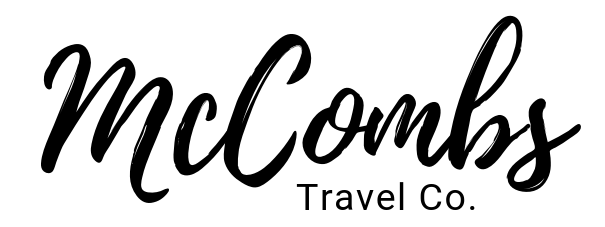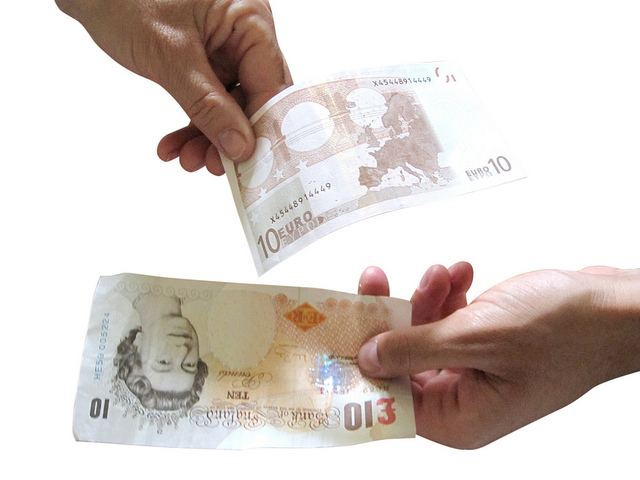Novice travelers to Europe often have a bit of trepidation when it comes to obtaining local currency abroad. While there are several solutions to this dilemma, I thought I’d take a moment to discuss what we’ve found to be a best practice in getting Euros, Franks, Pounds, etc. across the pond.
There are few methods that are often suggested when it comes to obtaining foreign currency. Some of the most common methods are:
- Buying currency from your local bank prior to travel.
- Using a currency exchange in your destination country.
- Buying foreign currency from an online exchange.
- Using your ATM/Debit card abroad.
Before discussing what we view to be the BEST option, I’d like to discuss the reasons that the others are less desirable.
Buying currency from your local bank prior to travel: While this method may give you peace of mind and prove convenient, we see a couple of issues here. First, exchange rates generally aren’t that favorable when using your local financial institution to change money. In many cases, local banks don’t keep foreign currency on hand, so they are actually buying the currency from a larger institution. This means that you are not only paying the exchange rate and spread being offered by the larger institution, you’re paying an additional fee to your local bank.
Using a currency exchange in your destination country: This is another convenience option that may prove costly. I mean, what could be easier than arriving at the airport in your destination country, walking to the exchange desk, and getting some local cash? Truth be told, our PREFERRED METHOD is just as easy, and far less costly. Currency exchange desks are notorious for charging exorbitant fees in excess of the exchange rate. This just means that you’re paying more for your own money than it’s worth.
Buying foreign currency from an online exchange: Similar to purchasing at your local bank, this is an option that provides peace of mind and convenience. It’s nice having that currency before you head abroad, but this method will almost always cost you in terms of convenience fees in excess of the exchange rate.
Before I discuss our preferred method for obtaining foreign currency, I wanted to discuss a little bit of the terminology surrounding currency exchange and the spread charged by exchange companies to make money off of you. At the time of this blog entry, the published exchange rate from USD to Euros was 1 USD to 0.929347 EUR per www.xe.com. As such, $100 is worth 92.93 Euros. If you were to order 93 Euros on Travelex.com, it would cost you $110.71, plus a $9.99 delivery fee. So, you paid $120.70 for $100 worth of Euros.
If you do plan to utilize currency exchange desks abroad, we suggest installing phone apps like Coinverter Currency Converter, so you can see what you should be paying at the going rate vs. what the exchange desk will charge you. This app can be loaded and updated, then used offline. This is helpful if your phone is in airplane mode abroad. Just make sure to refresh the app before turning your phone data off so you have the most recent exchange rates possible.
Now, let’s discuss our preferred option……
Using your ATM/Debit card abroad: In almost all instances, we’ve found the cheapest and most convenient way to get cash abroad (specifically in Europe) is by using ATMs and the debit/atm card associated with your American bank account. Why is this the best, you ask? Well, EVERY ATM that we’ve encountered in Europe has not charged a fee for cash withdrawal. Additionally, every ATM that we’ve used in Europe also dispenses cash with no spread on the exchange rate. So, provided that your bank charges no or low foreign ATM fees, this can be a really cheap way to get cash when you travel. For this to be your best bet, you need to be sure that you’ve got your bases covered. Here is our list of tips for using your ATM to get cash:
- Know what your bank charges for using foreign ATMs. (Ours is $1 per transaction)
- Know if your bank charges additional fees for international charges. (Ours doesn’t)
- When using a foreign ATM, make sure that you know whether or not it charges a fee. (We’ve not seen any that charge fees in Europe)
- When the ATM gives you the option to withdrawal cash in the local currency or in your native currency, ALWAYS choose the local currency. This simply means that the foreign ATM will not perform an electronic currency conversion for this withdrawal. If you let the foreign ATM perform the currency exchange, you’ll get charged a fee.
- Know the exchange rate. Know what this withdrawal should cost you in USD.
- Always check for card skimmers placed with scammers trying to steal your card information.
- Always let your bank know that you’ll be traveling abroad to avoid having your card locked for a foreign transaction.
- Make sure to know your daily ATM withdrawal limits.
In our experience, we’ve always gotten the exact going exchange rate when using our ATM card to obtain cash in Europe. This, or course, is provided that we always chose for the machine to issue cash at the local currency rate. We simply pay $1 per transaction, as that is the only fee charged by our bank for international ATM usage.
It’s always best to explore all options when exchanging cash abroad, but we think that if you are informed from the start and follow our tips above, you can save yourself time and money.
Let us know your experience with currency conversion below. We’d love to hear if you agree, disagree, or something in between!


Recent Comments